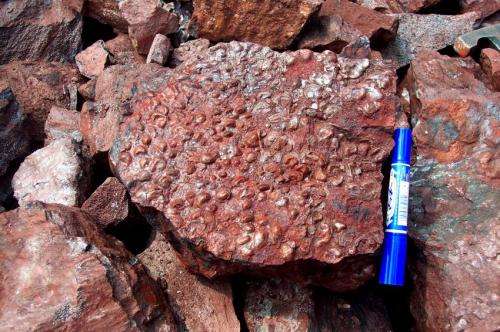Oxygen levels were only 0.1 percent of today's levels for roughly billion years before rise of animals

(Phys.org) —Geologists are letting the air out of a nagging mystery about the development of animal life on Earth.
Scientists have long speculated as to why animal species didn't flourish sooner, once sufficient oxygen covered the Earth's surface. Animals first appeared and began to prosper at the end of the Proterozoic period, about 600 to 700 million years ago—but what about the billion-year stretch before that, when most researchers think there was also plenty of oxygen?
Evidently, the air was not oxygen-rich enough then, a team of researchers has found. In a study published online Oct. 30 in Science, the researchers report that oxygen levels during the billion or more years before the rise of animals were only 0.1 percent of what they are today.
"In other words, Earth's atmosphere couldn't have supported a diversity of creatures, no matter what genetic advancements were in place," said coauthor Timothy W. Lyons, a distinguished professor of biogeochemistry in the Department of Earth Sciences at the University of California, Riverside.
According to the researchers, while there is no question that genetic and ecological innovation are ultimately behind the rise of animals, there is also no question that for animal life to flourish a certain level of oxygen is required.
"We're providing the first evidence that oxygen levels were low enough during this period to potentially prevent the rise of animals," said Yale University biogeochemist Noah J. Planavsky, co-lead author of the research along with Christopher Reinhard of the Georgia Institute of Technology. Planavsky and Reinhard, recent graduates of UC Riverside, began these studies while in Lyons' lab.
The scientists found their evidence by analyzing chromium isotopes in ancient sediments from China, Australia, Canada and the United States. Chromium is found in the Earth's continental crust, and chromium oxidation, the process recorded by the chromium isotopes, is directly linked to the presence of free oxygen in the atmosphere.
Specifically, the team studied samples deposited in shallow, iron-rich ocean areas, near the ancient shoreline. They compared their data with other samples taken from younger locales deposited in similar settings but known to have higher levels of oxygen.
The question about the role of oxygen in controlling the first appearance of animal has long vexed scientists. "We were missing the right approach until now," Planavsky said. "Chromium gave us the proxy." He explained that previous estimates, which put the oxygen level at 40 percent of today's conditions during pre-animal times, were based on very loose constraints, leaving open the possibility that oxygen was already plenty high to support animal life, and shifting the absence of animal life before the end of the Proterozoic to other controls.
In their study, the authors acknowledge that oxygen levels were highly dynamic in the early atmosphere, with the potential for occasional spikes. However, it also seems clear that there are first-order differences in the nature of Earth surface chromium cycling before the rise of animals versus the time interval coincident with their first appearance—implying vanishingly small oxygen conditions before.
These differences are recorded in a dramatic shift in the chromium isotope data, with clear signals of cycling beneath a more oxygen-rich atmosphere at the time the animals appear. "If we are right, our results will really change how people view the origins of animals and other complex life and their relationships to the co-evolving environment," said Lyons. "This could be a game changer."
More information: "Low Mid-Proterozoic atmospheric oxygen levels and the delayed rise of animals." Science 31 October 2014: Vol. 346 no. 6209 pp. 635-638 DOI: 10.1126/science.1258410
Journal information: Science
Provided by University of California - Riverside




















